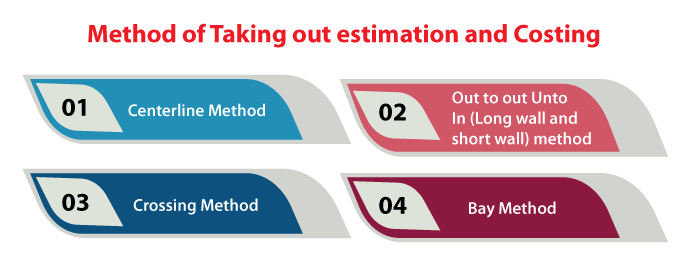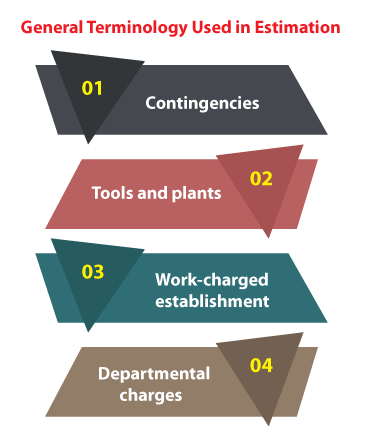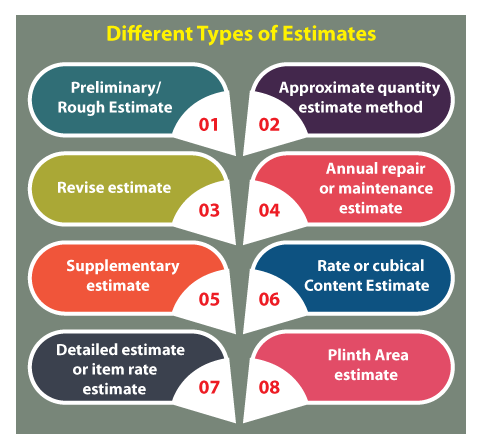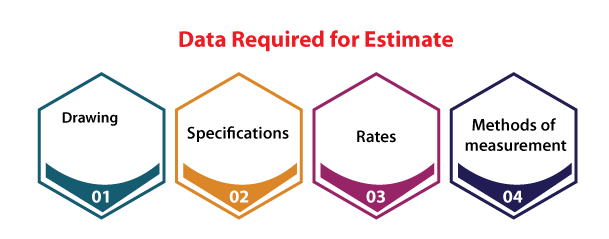Estimation and CostingEstimation and costing are nearly synonymous terms. The term "estimation" refers to a method of calculating or computing several quantities as well as the anticipated cost of a specific project or work. The estimate gives us an idea of how much the job might cost. The primary purpose of estimation is to help us understand the potential cost of the project before it's finished. If we make our estimates properly and appropriately, the discrepancy between estimated and actual costs will be minimal. Importance of Estimation and CostingThe following are some of the reasons why estimation and costing are so important:
Methods of Taking out Estimation and Costing
Quantities of materials can be calculated using a variety of estimation techniques. Individual approaches are used depending on the building's design and shape. The following are different methods: 1. Centerline MethodsGenerally, we use this method when offsets are symmetrical, and the shape of the building is in the form a rectangle. This centerline serves as length for the estimate's whole calculation. If the deductions are not taken into account, the estimation may be incorrect. The same portion should be on all of the walls. 2. Crossing MethodThe length and breadth of the masonry walls at the plinth level are used to calculate quantities (internal dimension of the room + thickness of the walls). As in the case of the centerline technique, the symmetrical offset is significant. The centerline length is obtained by calculating the total perimeter of the building and subtracting four times the thickness of the wall on it. 3. Out to Out and Into In (Long Wall and Short Wall) MethodIn this method, the wall along the room's length is considered a longwall white, with the at right-angles to the longer wall is called the short wall. If we want to calculate the length of the short wall or long wall, we have first to calculate the centerline lengths of distinct walls. Then the longwall's length (out to Out) can be estimated after adding half breadth at every end to its centerline length. So, the short wall's length is calculated by subtracting half breadth from its centerline length at each end. 4. Bay MethodWe generally used this method in the case of the building having various bays. The overall cost of the building is calculated by multiplying the cost of one classroom by the number of bays in that building. The additional cost is needed for the end walls and framing discrepancies. What is Estimation?The procedure of calculating the measures according to the authorized drawings and cost of several construction items, i.e., excavation, Plaster, concreting, etc. known as an "estimate." Before beginning any construction project, the owner or contractor must have a clear understanding of the scope and expense of the work. As a result, it's critical to have a rough estimate of the amount of work needed and a thorough knowledge of the amount of work that is to be done and the entire cost. Purpose of EstimationThe following are the purpose of Estimation:
General Terminology Used in Estimation
The general terminology which we used in estimation are: 1. ContingenciesContingencies show the incidental expenses of miscellaneous work that cannot be explained in the estimation. Generally, the contingency amount is 3% to 5% of the estimated cost. 2. Tools and PlantsIn order to arrange tools, equipment, and plants there is 1% to 1.5% of the estimated cost is kept. 3. Work-Charged EstablishmentWork-charged staff is temporarily appointed for a particular period of time. They can terminate within a one-month notice period. This is generally 1.5% to 2% of the estimated cost. 4. Department ChargesThese are supervision charges for the work that is generally 10% to 15% of the estimated cost. Types of Estimates
There are various types of estimates. 1. Preliminary/Rough EstimatePreliminary/Rough estimate is also called budget estimate or cost estimate. We prepared this estimate to understand the rough cost of the project at the starting stage of the project. Preliminary/rough estimate is based on the construction such as flooring, lighting, and ceilings. 2. Approximate Quantity Estimate MethodIn the case of the approximate quantity estimate method, the wall lengths of the structure are measured and added. The cost of the structure is then calculated by multiplying the total length by the rate per running meter. 3. Revise EstimateWe have to prepare the revised estimate if the detailed estimate exceeds the original sanction value by 5%. This estimate has been amended to identify any flaws and adapt them to meet the requirements of standard guidelines. 4. Annual Repair or Maintenance EstimateWe prepare annual Repair or maintenance estimate in advance to determine the cost of future maintenance or repairs which will be required in the long run. It may include estimated for Painting, any repairing, and whitewashing. 5. Supplementary EstimateWhen additional work on-site occurs that was not previously mentioned in the initial estimate; a supplementary estimate is generated. 6. Rate or Cubical Content EstimateCube rate or cubical content estimate is based on volumetric measurement of the structure. This estimate is derived by multiplying the plinth area of the building by the height of the structure. 7. Detailed Estimate or Item Rate EstimateOnce the appropriate authority has accepted the preliminary estimates, a detailed estimate or item rate estimate is generated. A detailed estimate or item rate estimate is the most correct estimation because it assesses each item individually. 8. Plinth Area EstimateThe plinth area of the building is used to calculate the plinth area. Plinth area means the area which is covered by the floor at the ground. In order to obtain this estimate, the plinth area is multiplied by the plinth area rate. Set back areas, open areas are not taken into account for the plinth areas. Data Required for Estimate
The data required for the estimate are:
1. DrawingsDrawings are required for calculating the quantities of materials to be used. Before preparing an estimate, the drawing must include plans, elevations, different sections, and other vital details with clear and complete dimensions. 2. SpecificationsThe term "specification" refers to explaining the nature, and class of the work, the materials to be utilized, and the workmanship to be performed, and it is required for the task to be accomplished. Specifications can be classified into two types:
General Specification In general words, the general specification provides a basic idea regarding nature, class and materials in general terms to be used in different kinds of work. Detailed Specification The detailed specification describes the different elements of work in detail, including the amounts and quantities of materials used, the technique of preparation, their proportions, workmanship, and execution of work. 3. RatesRates are essential for calculating estimations by multiplying material quantities with unit rates. In order to prepare an estimate, we will need the unit rates for each item of work. Each item's unit rates are derived from:
4. Methods of MeasurementUpdated mode of measurement for standard deductions or additions is also necessary to determine the correct quantities of work.
Next TopicYahoo Image Search
|
 For Videos Join Our Youtube Channel: Join Now
For Videos Join Our Youtube Channel: Join Now
Feedback
- Send your Feedback to [email protected]
Help Others, Please Share










